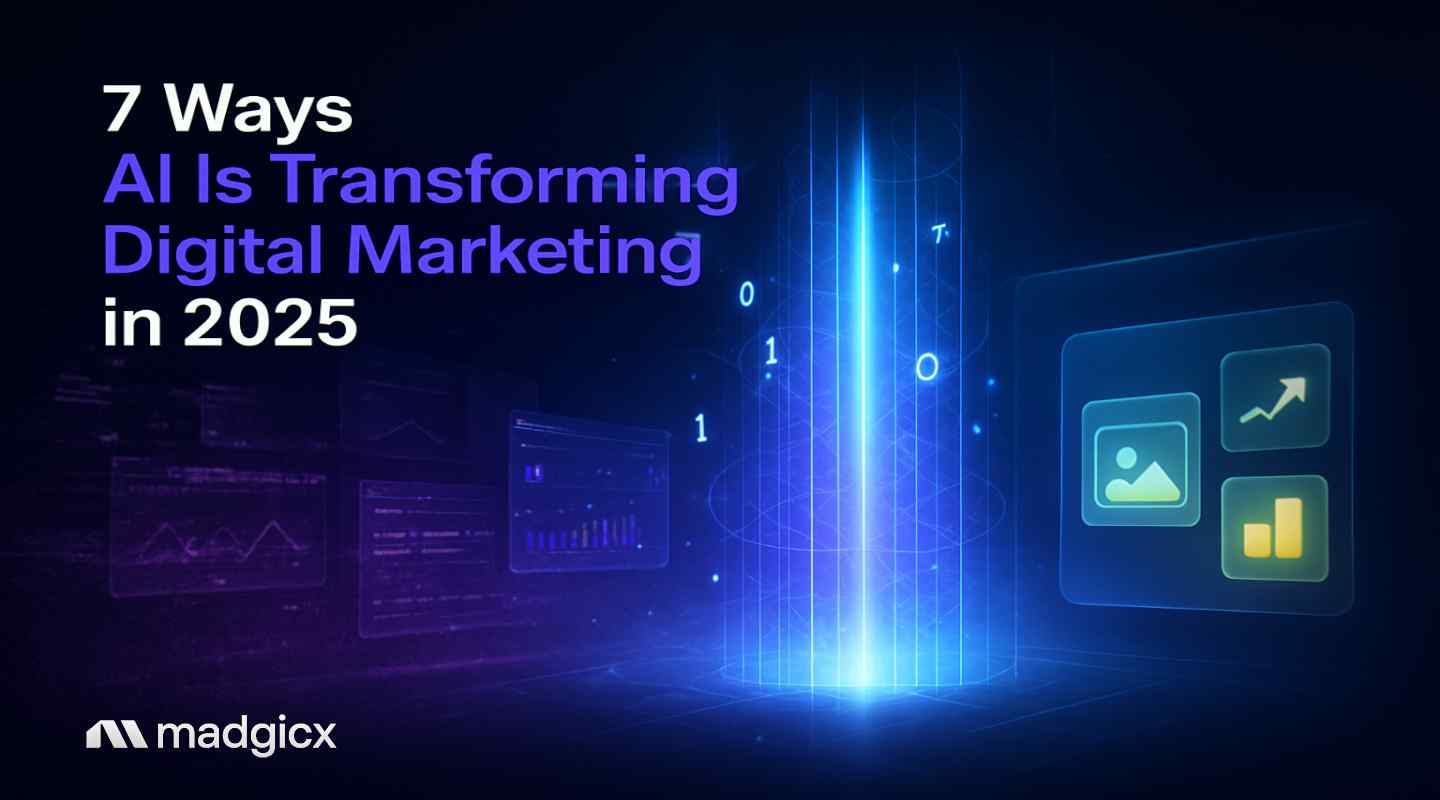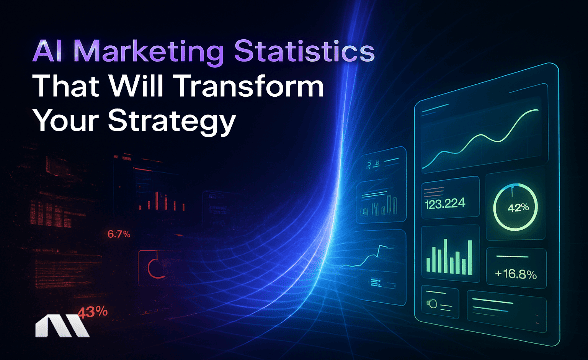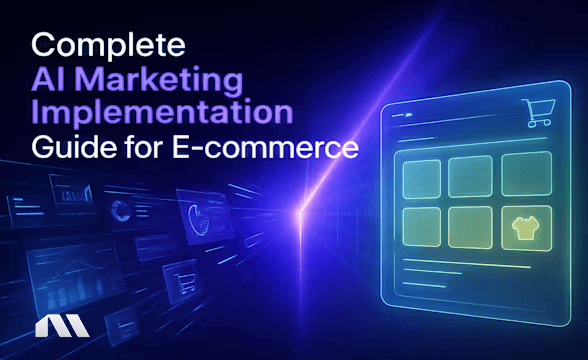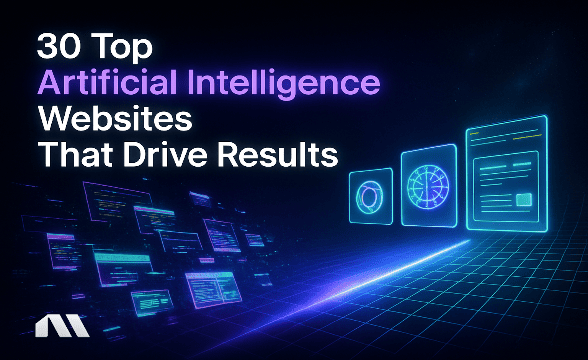Discover how AI is transforming digital marketing with 7 proven strategies that deliver higher ROI. Get data, implementation guides, and future predictions.
Picture this: Sarah's Shopify store was struggling with $5,000 monthly ad spend on Facebook ads with results that swung wildly from feast to famine. One month she'd hit her target ROAS, the next she'd barely break even. Sound familiar?
Then Sarah discovered AI marketing automation, and everything changed.
She's not alone in this transformation. According to recent industry research, 98% of marketers now use AI in some capacity, and companies leveraging how AI is transforming digital marketing see 20-30% higher ROI on campaigns compared to traditional methods. That's not just a slight improvement – that's the difference between struggling to stay profitable and scaling with confidence.
In this guide, you'll discover exactly how AI is transforming digital marketing and get step-by-step strategies to implement these changes in your own e-commerce business. We're talking real ROI data, practical implementation tips, and the specific AI transformations that separate thriving online stores from those stuck in the advertising hamster wheel.
What You'll Learn
- How AI personalization increases conversion rates by 202%
- 7 specific AI transformations driving 20-30% ROI improvements
- Step-by-step implementation guides for each AI strategy
- Bonus: Future AI predictions for 2025-2026 with preparation timelines
AI-Powered Personalization: The 202% Conversion Boost
Here's where things get interesting. AI personalization isn't just about slapping someone's first name in an email subject line anymore. We're talking about sophisticated systems that analyze thousands of data points to deliver individualized experiences that feel remarkably intuitive.
What AI personalization actually means: AI analyzes customer behavior patterns, purchase history, browsing data, and engagement signals to deliver completely customized experiences for each visitor. Think Netflix recommendations, but for your product catalog and ad targeting.
According to Epsilon research, 92% of businesses use AI-driven personalization to improve customer experiences. But here's the kicker – companies implementing advanced personalization see CTAs improve by up to 202%.
Real e-commerce example: Instead of showing the same homepage to everyone, AI analyzes that Sarah (our Shopify store owner) has been browsing winter coats, previously bought accessories, and tends to shop on mobile during lunch breaks. The AI automatically adjusts her homepage to feature winter coat collections, suggests matching accessories, and optimizes the mobile experience for quick purchasing.
For Facebook advertising specifically, this means your campaigns can automatically adjust creative, copy, and targeting based on real-time performance data. Madgicx's AI Marketer takes this a step further by continuously optimizing your campaigns 24/7, helping you make micro-adjustments that human marketers simply can't keep up with.
Pro Tip: Start with email personalization before expanding to ads. It's easier to implement, provides immediate feedback, and builds the data foundation you'll need for more advanced marketing AI applications.
Intelligent Content Creation: From Hours to Minutes
Remember when creating a single Facebook ad meant hours of brainstorming, designing, writing copy, and testing variations? Those days are officially over.
AI content creation has evolved from "robot-sounding" copy to genuinely engaging content that converts.
The transformation: AI now generates ad copy, images, and even video content that's specifically optimized for your audience and platform. We're seeing a reduction in creative production costs while maintaining (and often improving) performance quality.
How this works in practice: You upload a product image and basic details. The AI analyzes your brand voice, successful competitor ads, and platform best practices to generate multiple ad variations. Each variation is optimized for different audience segments and campaign objectives.
Madgicx's AI Ad Generator exemplifies this transformation. Instead of hiring expensive designers or spending hours in Canva, you can create thumb-stopping image ads in seconds. The AI editor then optimizes these images based on what's currently working in your industry and target market.
Implementation strategy:
- Start with your best-performing existing ads as templates
- Use AI to generate 5-10 variations of each winning creative
- Test these variations against your originals
- Let the AI learn from performance data to improve future generations
- Scale the winning combinations
The beauty of this approach? You're not replacing human creativity – you're amplifying it. Your strategic thinking guides the AI, while the AI handles the time-consuming execution and optimization.
Pro Tip: Always maintain brand consistency by training the AI on your existing high-performing content before letting it generate new variations.
Predictive Analytics: Know What Works Before You Spend
This is where AI gets impressively accurate. Predictive analytics uses historical data, market trends, and behavioral patterns to forecast campaign performance before you spend a single dollar. It's like having advanced forecasting capabilities for your advertising budget.
The business impact: Companies using predictive analytics report reducing wasted ad spend by 40-60%. That's not just efficiency – that's the difference between profitable scaling and burning through your marketing budget.
How predictive analytics transforms your strategy: Instead of launching campaigns and hoping for the best, AI analyzes your historical performance, current market conditions, and competitor activity to predict which audiences, creatives, and budgets will deliver the best results.
For e-commerce specifically, this means predicting which products will trend, which audiences are most likely to convert, and even which times of day will deliver the best ROAS.
Madgicx's predictive audience targeting takes this concept and applies it directly to Facebook advertising. The platform analyzes your existing customer data to predict which lookalike audiences will perform best, often identifying profitable segments you never would have considered manually.
Quick implementation steps:
- Upload your customer list to your AI platform
- Let the AI analyze purchasing patterns and behavior data
- Create predictive lookalike audiences based on lifetime value
- Test these audiences against your current targeting
- Scale the highest-performing predictions
Pro Tip: Start with lookalike audience predictions. They're easier to implement and typically show results within 2-3 weeks of testing.
Automated Bid Management: 24/7 Optimization
While you're sleeping, your competitors might be manually adjusting their Facebook ad bids. Meanwhile, AI-powered bid management is making thousands of micro-optimizations to squeeze every ounce of performance from your campaigns.
The ROI benefit: Automated bid management typically delivers 25-35% improvement in cost-per-acquisition compared to manual bidding strategies. That's because AI can process signals and make adjustments faster than any human marketer.
How it actually works: AI analyzes real-time auction data, user behavior signals, conversion probability, and dozens of other factors to adjust bids millisecond by millisecond. It's not just about bidding higher or lower – it's about bidding the exact right amount for each specific auction.
Think about it this way: Facebook's ad auction happens billions of times per day. Each auction considers the advertiser's bid, ad quality, and estimated action rates. AI can optimize for all these factors simultaneously while humans can barely keep track of daily performance.
Madgicx's AI Marketer handles this AI-assisted bid optimization as part of its comprehensive optimization suite. The system monitors your campaigns 24/7, automatically adjusting bids based on performance trends, audience behavior, and market conditions.
5-step automation configuration:
- Set your target CPA or ROAS goals
- Define minimum and maximum bid limits
- Choose optimization windows (daily, weekly, or custom)
- Enable automated budget reallocation between ad sets
- Set up performance alerts for significant changes
The key is starting conservatively and letting the AI learn your account's patterns before giving it full autonomy.
Pro Tip: Begin with a 20% budget allocation to automated bidding, then gradually increase as you see positive results and build confidence in the system.
Cross-Platform Attribution: See the Full Customer Journey
Here's a painful truth: most e-commerce businesses lack complete visibility into their customer journey. iOS 14.5 made this worse, but AI-powered attribution is fighting back with sophisticated tracking that goes beyond traditional pixels.
The challenge AI solves: Modern customers don't follow linear paths to purchase. They might see your Facebook ad on mobile, research on desktop, compare prices on their tablet, and finally purchase on their phone three days later. Traditional tracking misses most of this journey.
How AI attribution works: Advanced attribution modeling uses machine learning to connect these scattered touchpoints, providing a complete picture of what's actually driving conversions. This isn't just about recovering lost data – it's about understanding customer behavior at a deeper level.
For Shopify stores specifically, this means finally understanding which marketing channels deserve credit for sales. You might discover that your Facebook ads are actually driving customers who convert through Google search, or that email marketing is the final push for customers who discovered you through social media.
Madgicx's Cloud Tracking addresses this challenge head-on with server-side first-party tracking that specifically tackles iOS 17 data collection challenges. This improved data quality leads to better Facebook optimization and more accurate ROI calculations.
Implementation for Shopify stores:
- Set up server-side tracking to capture first-party data
- Implement cross-device tracking using customer IDs
- Create attribution models that account for multi-touch journeys
- Use this data to optimize budget allocation across channels
- Continuously refine attribution windows based on your sales cycle
The result? More accurate data leads to better optimization, which leads to improved ROI across all your marketing channels.
Voice and Visual Search Optimization
While everyone's focused on traditional search and social media advertising, smart e-commerce businesses are preparing for the next wave: voice and visual search. AI is making these technologies mainstream, and early adopters are gaining significant advantages.
The growth opportunity: Industry predictions suggest that 50% of searches will be voice-based by 2025, while visual search is growing even faster among younger demographics. For e-commerce, this represents a massive shift in how customers discover products.
Voice search transformation: AI-powered voice assistants are getting better at understanding natural language and purchase intent. Instead of typing "red running shoes size 9," customers are saying "find me comfortable running shoes for my morning jogs in red."
Visual search evolution: Customers can now take a photo of a product they like and find similar items instantly. Pinterest Lens, Google Lens, and Amazon's visual search are training customers to shop with their cameras.
E-commerce application strategies:
- Optimize product descriptions for conversational queries
- Use natural language in your ad copy and product titles
- Implement structured data markup for voice search results
- Create visual content that performs well in image search
- Develop voice-optimized FAQ sections
Action steps for voice search optimization:
- Use tools like Answer The Public to find question-based queries
- Analyze your customer service conversations for natural language patterns
- Optimize for local voice searches if you have physical locations
- Create content that answers specific product questions
- Test voice search performance using mobile devices
The businesses implementing these strategies now will have significant advantages as voice and visual search become dominant discovery methods.
Pro Tip: Start by optimizing your top 10 product pages for voice search queries. Focus on answering the questions "What is [product]?" and "Where can I buy [product]?"
Ethical AI and Future-Proofing Your Strategy
Here's something most AI marketing guides won't tell you: the biggest risk isn't falling behind on AI adoption – it's implementing AI in ways that damage customer trust or violate emerging regulations.
The trust factor: 73% of consumers are concerned about AI privacy, but they're also willing to share data for personalized experiences when they trust the brand. The key is transparent, ethical AI implementation that puts customer value first.
Regulatory landscape: 2025-2026 will bring significant AI regulation changes. The EU's AI Act is already in effect, and similar legislation is coming to other markets. Businesses need to build compliance into their AI strategies now, not after regulations are enforced.
Best practices for ethical AI marketing:
- Always disclose when AI is generating content or making recommendations
- Provide clear opt-out mechanisms for AI-powered personalization
- Regularly audit AI systems for bias and discrimination
- Implement data minimization principles (collect only what you need)
- Create transparent privacy policies that explain AI usage
Building customer trust:
- Use AI to enhance customer experience, not manipulate behavior
- Provide value in exchange for data sharing
- Give customers control over their personalization settings
- Be transparent about how AI improves their experience
- Regularly communicate your ethical AI commitments
2025-2026 predictions and preparation strategies:
- Increased regulation will require AI transparency reports
- First-party data will become even more valuable as third-party cookies disappear
- AI-generated content will need clear labeling requirements
- Customer consent mechanisms will become more sophisticated
- Businesses with ethical AI practices will gain competitive advantages
The companies that build trust and compliance into their AI strategies now will be the ones that thrive as the regulatory landscape evolves.
The AI Marketing Tech Stack: Putting It All Together
Understanding individual AI transformations is just the beginning. The real power comes from integrating these technologies into a cohesive marketing system that works together seamlessly.
Essential components of an AI marketing tech stack:
- AI-powered advertising platform (like Madgicx for Facebook/Instagram optimization)
- Predictive analytics software tools for forecasting and planning
- Content generation systems for scalable creative production
- Attribution and tracking solutions for accurate measurement
- Customer data platform for unified audience insights
For e-commerce businesses, this integration is crucial because your customers interact with multiple touchpoints. Your AI systems need to share data and insights to create truly personalized experiences.
Many successful e-commerce businesses are discovering that comprehensive AI marketing tech stacks deliver exponentially better results than individual point solutions. The synergy between different AI tools creates optimization opportunities that wouldn't exist with manual management.
For a deeper dive into building your complete AI marketing infrastructure, check out our comprehensive guide to AI marketing tech stacks.
Implementation priority for e-commerce:
- Start with advertising automation (fastest ROI)
- Add content generation capabilities
- Implement advanced attribution tracking
- Integrate predictive analytics
- Build comprehensive personalization systems
The key is building your stack incrementally, ensuring each component integrates well with your existing systems before adding the next layer.
Pro Tip: Choose AI tools that offer native integrations with your existing platforms. This reduces setup time and ensures better data flow between systems.
Real-World Success Stories: AI Marketing in Action
Let's look at how companies are actually using AI to transform their marketing results. These aren't theoretical examples – they're real businesses achieving measurable improvements.
Case Study 1: E-commerce Fashion Brand
- Challenge: High customer acquisition costs and low repeat purchase rates
- AI Solution: Implemented predictive analytics for inventory planning and personalized product recommendations
- Results: 45% increase in average order value, 30% improvement in customer lifetime value
Case Study 2: Subscription Box Service
- Challenge: Difficulty predicting churn and optimizing retention campaigns
- AI Solution: Used machine learning to identify churn signals and automate retention campaigns
- Results: 25% reduction in churn rate, 40% improvement in retention campaign ROI
Case Study 3: B2B SaaS Company
- Challenge: Manual lead scoring and inefficient ad targeting
- AI Solution: Automated lead scoring and predictive audience targeting
- Results: 60% improvement in lead quality, 35% reduction in cost per qualified lead
These examples demonstrate that AI marketing isn't just about efficiency – it's about discovering opportunities and insights that human analysis would miss.
For more detailed case studies and implementation strategies, explore our guide on how companies are using AI to transform their marketing.
Measuring AI Marketing Success: KPIs That Matter
Implementing AI marketing without proper measurement is like driving with your eyes closed. You need specific KPIs that demonstrate AI's impact on your business results.
Essential AI marketing metrics:
- Efficiency gains: Time saved on manual tasks, automation coverage percentage
- Performance improvements: ROAS improvements, CPA reductions, conversion rate increases
- Predictive accuracy: How often AI predictions match actual results
- Customer experience: Personalization engagement rates, customer satisfaction scores
- Revenue impact: Incremental revenue attributed to AI optimizations
Advanced measurement strategies:
- Set up control groups to isolate AI impact
- Track long-term customer value improvements
- Monitor AI system learning curves and optimization trends
- Measure cross-channel attribution improvements
- Calculate total cost of ownership including AI tool costs
The businesses seeing the best results from AI marketing are those that treat measurement as seriously as implementation.
FAQ
How much does AI marketing cost for small e-commerce businesses?
Most AI marketing tools start at $99-299/month, but the 20-30% ROI improvement typically pays for itself within the first month of implementation. For example, if you're spending $5,000/month on Facebook ads and achieve a 25% efficiency improvement, that's $1,250 in monthly savings – more than enough to cover most AI tool costs.
Do I need technical skills to implement AI marketing?
No – modern AI marketing platforms like Madgicx are designed for non-technical users with drag-and-drop interfaces and automated setup wizards. The most complex part is usually connecting your data sources, which most platforms handle with step-by-step guides.
Will AI replace human marketers?
AI enhances human creativity rather than replacing it. The most successful marketers use AI for optimization and execution while focusing their time on strategy, creative direction, and customer relationship building. Think of AI as your most efficient assistant, not your replacement.
How quickly can I see results from AI marketing?
Most businesses see initial improvements within 2-4 weeks, with full optimization benefits appearing after 60-90 days of data collection. The timeline depends on your current ad spend, data quality, and which AI tools you implement first.
Is AI marketing suitable for all business sizes?
Yes – AI marketing tools now offer solutions for businesses spending $1,000/month to $100,000+ monthly on advertising, with scalable pricing and features. Many AI platforms offer free trials or freemium tiers, making it accessible for businesses of all sizes to test the technology.
Transform Your Marketing with AI Today
The AI marketing revolution isn't coming – it's here. With 98% of marketers already using AI for competitive advantage, the question isn't whether you should adopt these technologies, but how quickly you can implement them effectively.
The seven transformations we've covered – personalization, content creation, predictive analytics, automated bidding, attribution, voice/visual search, and ethical implementation – represent the foundation of modern digital marketing. Companies implementing these strategies are seeing 20-30% ROI improvements while their competitors struggle with manual optimization.
But here's the thing: how AI is transforming digital marketing isn't about replacing human insight with robot efficiency. It's about amplifying your strategic thinking with intelligent automation. The most successful e-commerce businesses are those that combine human creativity with AI optimization, creating marketing systems that scale efficiently while maintaining authentic customer connections.
Your next step: Start with one AI transformation – automated bid management typically delivers the fastest ROI improvements. Madgicx's AI Marketer can have you optimizing campaigns within 24 hours, providing the foundation for more advanced AI implementations.
The AI marketing revolution is happening now. Join the 98% of successful marketers already using AI to scale their businesses, or risk being left behind by competitors who embrace these transformative technologies.
Ready to join the 98% of marketers using AI to boost ROI? Madgicx's AI-powered platform combines automated optimization with creative generation, specifically designed for e-commerce scaling. Get 20-30% higher campaign performance while dramatically reducing manual optimization time.
Digital copywriter with a passion for sculpting words that resonate in a digital age.







.avif)







